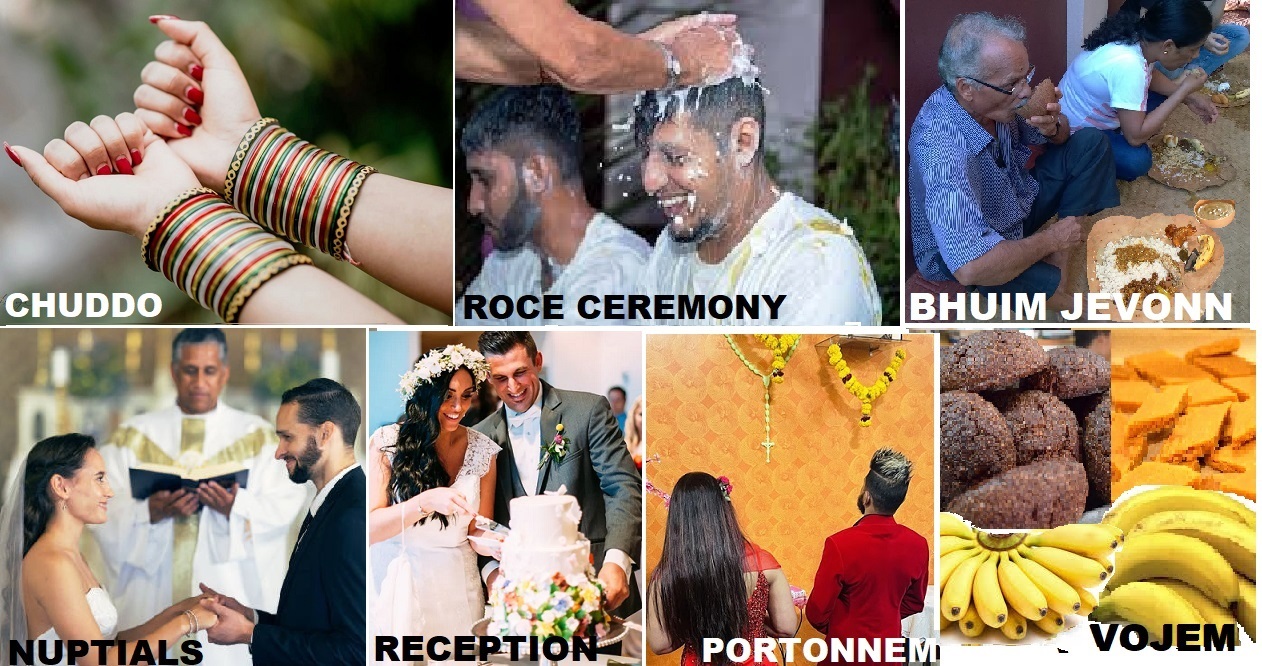
Catholic weddings are occasions filled with festivities and rooted in faith. December, April, and May are peak seasons, with top wedding services often reserved a year in advance.
In the past, Raibari or Soirikar arranged marriages by proposing to the boy's or girl's family. Once both families agree, the engagement is traditionally held at the groom's place, where rings are exchanged with family, priests, and friends. After this, the relatives of the bride and groom shop for fabrics for the bridal gown, bridesmaid dresses, saddo, and the bride's outfit for the day after the wedding.
Next, the wedding banns are read in the church three consecutive Sundays a few weeks before the wedding. This informs the public of the impending marriage, and they can raise objections.
Chuddo
In Goan weddings, bangles are a key bridal accessory, with the bride wearing the finest. After the first bann, the bride dons the Chuddo (glass bangles) at her maternal uncle's house. During the Chuddo ceremony, the kankonkar or volar (bangle seller) puts the bangles on the bride's hands in the accompaniment of 'zotim,' which are special commemorative songs. The Chuddo symbolises the married life of the bride.
Ros
Another ceremony known as Ros – the equivalent of the Haldi in Hindu culture, is held 2-3 days before the wedding. Here, the bride and the groom, each at their respective residences, are bathed in coconut milk. The invitees put the Ros on the head of the bride/groom, which symbolises purification and signals the end of spinsterhood and bachelorhood. After this, the couple traditionally stays home until the wedding day as a precaution to avoid accidents before the nuptials. A sweet dish made of rice, coconut, and jaggery known as 'atoll' is served at the end of the Ros ceremony.
Bikareanchem/ Bhuim Jevonn
Before the wedding, a lunch called Bikareanchem Jevonn is held to honour the less fortunate and give thanks to departed souls. Before cooking this meal, a senior family member breaks a coconut in front of the house. The specialty of this lunch is a spicy, aromatic dry prawn curry known as 'samarachi koddi' that is cooked with dry, unripe salted mango (mango sol) and boiled rice. 'Voddes' made of rice and urid dal are also served. A sweet made of wheat and sugar cooked in coconut juice known as 'soji' and another made of gram dal, coconut juice and jaggery known as 'Vonn' is also served. Sitting on a coconut husk on the mat spread on the floor is customary, with food served on stitched jackfruit leaves.
Dennem
Known as the dowry, this Goan wedding tradition involves the bride's family providing essentials like jewellery, clothes, furniture, and kitchenware for her married life. A small image or statue of Baby Jesus is an important inclusion. The bride's parents also give cash. This is counted by an elderly family member known as 'yezman'.
On the wedding day, a close relative of the groom brings the wedding gown and helps the bride dress up. Before going to the church, all close relatives and friends bless the bride and the groom in their respective residences. The groom sends a wedding car to drop the bride to the church. At the nuptials, the couple exchange vows, and the priest declares they are man and wife as church bells ring.
After the nuptials, the bride is welcomed into her new home, where the groom's mother places a gold chain around her neck and the saddo on her shoulder. Prayers, such as the Tedeao, are recited.
They proceed to the reception, where the wedding cake is cut, followed by dancing, merrymaking, and food and drinks being served. A toast is also raised for the happiness and prosperity of the married couple.
At the end of the reception, relatives, and friends form an imaginary line called xim. The bride's family stands on one side, and the groom's family on the other. Prayers are offered, and some of the bride's relatives cross the line to invite the couple to her home the next day for Apovnnem.
Apovnnem /Porthoponn
In this tradition, the bride’s family usually invites the groom’s family to their house the day after the wedding. The bride wears a bright red sari/dress called Saddo, and a huge feast is prepared. Both families get to mingle in a more casual and relaxed setting while getting to know each other better.
Xim or village boundary, is another wedding tradition mainly celebrated after the wedding. On either side of this boundary, the bride and groom’s family would stand, offer prayers, and recite holy verses. They shower blessings on the couple by pouring Cashew feni across the boundary by singing Viva re Viva Viva…Vokle Novreachi Saud korum-ia. The breaching of the xim is to finish all the disagreements or arguments between the two families and return home happily. Sometimes, liquor is poured into a coconut shell, and a vidi/cigarette packet is placed at the junction where the couple would pass, believed to protect them from evil and misfortune.
Vojem
It consists of sweet items offered by the bride’s family to be distributed among family, relatives, and villagers as a sign of gratitude for their help/support during the marriage. Some of it is then later returned to the bride’s family. The vojem includes Boll, Doce de Grao, and Bananas. The Doce is prepared at the Bride and Groom’s house while reciting Mandos and other holy verses to bestow blessings on the bride and the groom.
Goan wedding traditions strengthen family ties, with the celebration focused on joy, unity, and building bonds of togetherness.